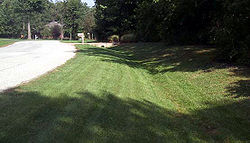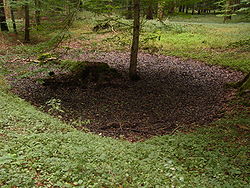.gif)
Swale (geographical feature)
Encyclopedia

Marsh
In geography, a marsh, or morass, is a type of wetland that is subject to frequent or continuous flood. Typically the water is shallow and features grasses, rushes, reeds, typhas, sedges, other herbaceous plants, and moss....
y. The term can refer to a natural landscape feature or a human-created one. Artificial swales are often designed to manage water runoff
Surface runoff
Surface runoff is the water flow that occurs when soil is infiltrated to full capacity and excess water from rain, meltwater, or other sources flows over the land. This is a major component of the water cycle. Runoff that occurs on surfaces before reaching a channel is also called a nonpoint source...
, filter pollutants
Water pollution
Water pollution is the contamination of water bodies . Water pollution occurs when pollutants are discharged directly or indirectly into water bodies without adequate treatment to remove harmful compounds....
, and increase rainwater infiltration
Infiltration (hydrology)
Infiltration is the process by which water on the ground surface enters the soil. Infiltration rate in soil science is a measure of the rate at which soil is able to absorb rainfall or irrigation. It is measured in inches per hour or millimeters per hour. The rate decreases as the soil becomes...
.
The swale concept has also been popularized as a rainwater harvesting
Rainwater harvesting
Rainwater harvesting is the accumulating and storing of rainwater for reuse before it reaches the aquifer. It has been used to provide drinking water, water for livestock, water for irrigation, as well as other typical uses. Rainwater collected from the roofs of houses and local institutions can...
and soil conservation
Soil conservation
Soil conservation is a set of management strategies for prevention of soil being eroded from the Earth’s surface or becoming chemically altered by overuse, acidification, salinization or other chemical soil contamination...
strategy by Bill Mollison
Bill Mollison
Bruce Charles 'Bill' Mollison is a researcher, author, scientist, teacher and naturalist. He is considered to be the 'father of permaculture', an integrated system of design, co-developed with David Holmgren, that encompasses not only agriculture, horticulture, architecture and ecology, but also...
, Geoff Lawton
Geoff Lawton
Geoff Lawton is a permaculture consultant, designer and teacher. He holds a diploma in permaculture design. Since 1995 he has specialized in permaculture education, design, implementation, system establishment, administration and community development....
and other advocates of permaculture
Permaculture
Permaculture is an approach to designing human settlements and agricultural systems that is modeled on the relationships found in nature. It is based on the ecology of how things interrelate rather than on the strictly biological concerns that form the foundation of modern agriculture...
. In this context it usually refers to a water harvesting ditch on contour. Another term used is contour bund.

Elevation
The elevation of a geographic location is its height above a fixed reference point, most commonly a reference geoid, a mathematical model of the Earth's sea level as an equipotential gravitational surface ....
contour line
Contour line
A contour line of a function of two variables is a curve along which the function has a constant value. In cartography, a contour line joins points of equal elevation above a given level, such as mean sea level...
), facilitating runoff infiltration into the soil. This type of swale is created by digging a ditch on contour and piling the dirt on the downhill side of the ditch to create a berm
Berm
A berm is a level space, shelf, or raised barrier separating two areas. Berm originates in the Middle Dutch and German berme and came into usage in English via French.- History :...
. In arid climates, vegetation (existing or planted) along the swale can benefit from the concentration of runoff.
The term beach swale is also used to describe long, narrow, usually shallow troughs between ridges on a beach, that run parallel to the coastline.
See also
- BioswaleBioswaleBioswales are landscape elements designed to remove silt and pollution from surface runoff water. They consist of a swaled drainage course with gently sloped sides and filled with vegetation, compost and/or riprap...
- GutterGutterpanels of a comic strip or comic book page*Gutter , the space between panes of postage stamps that creates configurations of "gutter pairs" or "gutter blocks"*Gutter, in interface design, the blank spaces that separate rows and columns in screen...
- Keyline designKeyline DesignKeyline design is a technique for maximizing beneficial use of water resources of a piece of land. The Keyline refers to a specific topographic feature linked to water flow...
- Rain gardenRain gardenA rain garden is a planted depression that allows rainwater runoff from impervious urban areas like roofs, driveways, walkways, parking lots, and compacted lawn areas the opportunity to be absorbed...
- Surface runoffSurface runoffSurface runoff is the water flow that occurs when soil is infiltrated to full capacity and excess water from rain, meltwater, or other sources flows over the land. This is a major component of the water cycle. Runoff that occurs on surfaces before reaching a channel is also called a nonpoint source...
- StormwaterStormwaterStormwater is water that originates during precipitation events. It may also be used to apply to water that originates with snowmelt that enters the stormwater system...
External links
- Fact Sheet: Grassed Swales from US Environmental Protection Agency
- Fact Sheet: Dry and Wet Vegetated Swales from Federal Highway AdministrationFederal Highway AdministrationThe Federal Highway Administration is a division of the United States Department of Transportation that specializes in highway transportation. The agency's major activities are grouped into two "programs," the Federal-aid Highway Program and the Federal Lands Highway Program...
- Wetlands of the Great Lakes: The Beach Swale & Dune and Swale Types from Michigan State UniversityMichigan State UniversityMichigan State University is a public research university in East Lansing, Michigan, USA. Founded in 1855, it was the pioneer land-grant institution and served as a model for future land-grant colleges in the United States under the 1862 Morrill Act.MSU pioneered the studies of packaging,...
- Video showing swales used to rehabilitate desert terrain

